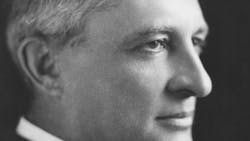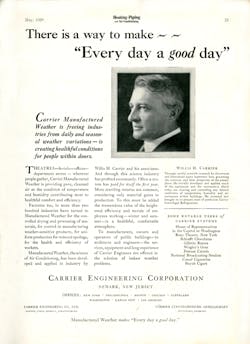Air Conditioning—New Prospects for an Established Industry
EDITOR'S NOTE: Eighty-five years ago this month (in May 1929), the first issue of HPAC Engineering, then called Heating Piping and Air Conditioning, was published. Among the inaugural issue’s articles was “Air Conditioning—New Prospects for an Established Industry,” by the man known for inventing modern air conditioning, Willis H. Carrier. On this Throwback Thursday, we take a look back at that article.
Twenty-five years ago "air conditioning" was an unknown quantity, either in theory or practice. Now it is a well established industry.
Today, air conditioning is recognized as a scientific method by which it is possible to control manufacturing conditions in certain industries, so that the products do not vary in quality from day to day and from season to season. Not only is quality maintained, but the production is not interrupted due to unfavorable weather conditions. Thus the cost of production is decreased.
Air conditioning undoubtedly is effecting an economic gain in various industries throughout this country of millions of dollars annually. In some industries, air conditioning equipment has been known to pay for itself in the first month of operation, while in others, calculable savings are found to pay for the equipment in the first three or four years.
The intangible advantages may be even of greater value. On the estimated amount of air conditioning equipment in use, and the average return to the user which it produces, it is probable that the present economic saving in the United States alone is nearly $15,000,000 annually.
Any normally healthy industry, especially if it be a relatively new industry, will show each year a geometric progression in its curve of increase. The curve of the air conditioning industry is one which shows a doubling in volume about every five years. This, of course, is much more rapid than the geometric curve of the growth in population of the country. While this may be explained in part by the increasing per capita purchasing power of the individual, the principal reason lies in the fact that air conditioning has decreased greatly the labor as well as the capital required per unit of production in such industries. Thus, air conditioning, by lessening the cost of production, has not only increased the profits of the manufacturer, but it has ultimately increased the purchasing capacity of the individual.
A Contributing Factor to Prosperity
Air conditioning may thus be classed with industrial electrification, automatic labor saving machinery, and increased transportation facilities, as one element contributing to the present day prosperity of the people of these United States.
Perhaps the most striking way of visualizing the economic contributions of air conditioning to the country's wealth and prosperity is to state, as we may be permitted to do on the foregoing basis, that it actually increases the average purchasing capacity of every man, woman and child in the United States twelve cents a year. Furthermore, taking into account the relative growth of air conditioning with respect to population and amortization of equipment, we may expect that the effect of this art upon the purchasing capacity of the American people will double every six years for some time to come. That is, in eighteen years from the present time, air conditioning may be expected to put into the pocketbook of each and every person in the United States annually one additional dollar.
From the standpoint of possible industrial economy, air conditioning is in its infancy. Air conditioning in conjunction with improved equipment has made it possible for one cigarette manufacturer to increase the output of his automatic machines four fold. During a temporary shutdown of air conditioning equipment in the factory of a prominent silk manufacturer, the lack of air conditioning reduced production 27 per cent. Never before had this manufacturer appreciated the significance of this new science.
The researches of the American Society of Heating and Ventilating Engineers at its laboratory in Pittsburgh, have studied the effects of temperature, humidity and air motion in relation to human comfort so that such applications are now placed on the basis of an exact science, and the effects which may be expected from air conditioning equipment are readily determined. This may be said to be one of the outstanding achievements of the research work of this society and it is becoming recognized in scientific circles throughout the world.
Will Become a Necessity
In the past we have given attention to the heating of our dwellings, offices and factories for the purpose of human comfort. In what now seems to us the "dark ages," this was considered a luxury rather than a necessity, as today. Similarly, in years to come, air conditioning and cooling for summer may become a necessity rather than a luxury, and we will look upon present times as marking the end of that "dark age" in which there was but relatively little cooling for human comfort.
The office skyscrapers of the future may find it preferable to dispense with windows and the street noises and dust which they admit, and avoid the great wastes in congested cities due to unoccupied courts and areaways now used for purposes of window ventilation and light. Sun-ray electric lighting may prove equally good and much more dependable than sunlight itself. Ventilation both in summer and winter can be made much better than outside conditions which at present permit either excessive dryness or an intolerable humidity within enclosures.
Use of Refrigeration Growing
The use of refrigeration in connection with air conditioning is growing apace. Motion picture theaters have found that air conditioning with refrigeration not only gives comfort to the patrons in summer, but, instead of showing an operative loss, has made the summer months the most profitable part of the year. People flock in to become cool and be comfortable as well as to see the show. At present, only a very small percentage of the total theaters are thus equipped. Eventually all theaters having a capacity of over a thousand seats will, of necessity, be equipped with air conditioning and refrigeration.
The larger department stores have found air conditioning essential to an effective campaign for summer sales. In fact, it is a producer of sales the year around. The Hudson stores of Detroit, Mich., were pioneers in this field. The installation in their basement required a capacity of six hundred tons of refrigeration, or the equivalent of fifty truck loads of ice in ten hours of operation during the hottest summer day. Their new building, which is now just being completed, will require practically twice this amount. Banks and offices are finding that air conditioning, with refrigeration for summer, is desirable. It is presumed that many other industries will eventually find such applications to their advantage.
Press Button—Heat or Cool Your Home
The use of refrigeration for maintaining comfortable living conditions in the home during extremes of summer heat will be a development of the very near future. It will be an improvement which can be applied to the home of the average man as well as to that of the wealthy. The application of thermal equipment for comfort in the home is of more importance than for office buildings or theaters, yet it has received far less engineering attention.
The home of the future will, in my opinion, be heated largely by air warmed directly by a gas or an oil-fired furnace, the warm air being distributed by noiseless, low-pressure fans. Such furnaces can now be built of rust-proof, light-weight steel at a relatively low cost, and will operate with an efficiency of approximately 90 per cent under all conditions. With this type of heating it is a relatively simple matter to attach air cooling by refrigeration, permitting the entire equipment to be located centrally in the basement.
Gas affords a suitable means for the production of such refrigeration. Some safe and simple absorption system may be developed, or an ejector type of system, using water as a refrigerant, may be the ultimate design; but, in any case, I venture to predict that it will soon be possible to press a button and place your house-heating system in operation under automatic control or to press another button to start your house-cooling system, as required.
This will bring the benefits and comforts of the mountains or seashore to our homes in summer, as well as the climate of Florida and other warm localities to our dwellings in winter.




